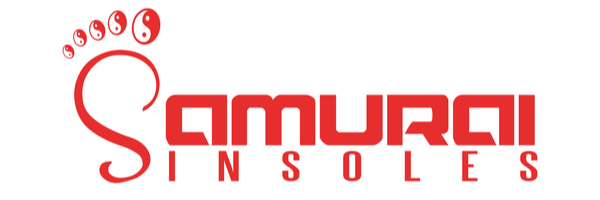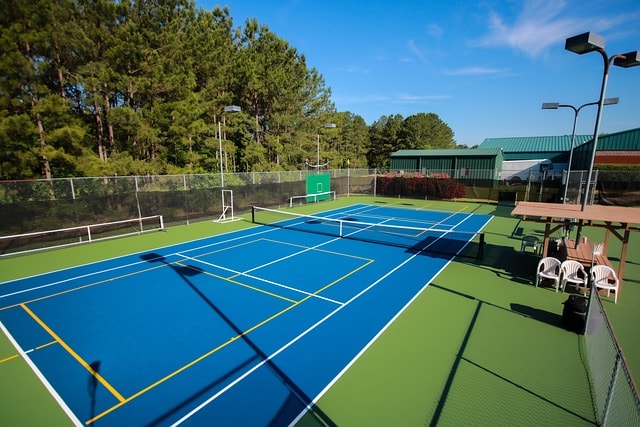If you’ve ever felt that sharp, stabbing pain in your heel—especially with those first few steps in the morning—you know how debilitating plantar fasciitis can be. Thankfully, specialized inserts for the plantar fascia are one of the most effective and straightforward ways to get relief without resorting to invasive treatments. These inserts act as a dedicated support system for your feet, cushioning your heel and propping up your arch to take the strain off that inflamed ligament.
Your First Step to Ending Nagging Heel Pain
Let's be real for a moment. That first step out of bed can be absolutely excruciating. It’s a frustrating cycle: the pain might ease up during the day, but it comes roaring back after you’ve been off your feet for a while. This guide is designed to help you break that cycle and finally take back control from that nagging heel pain.
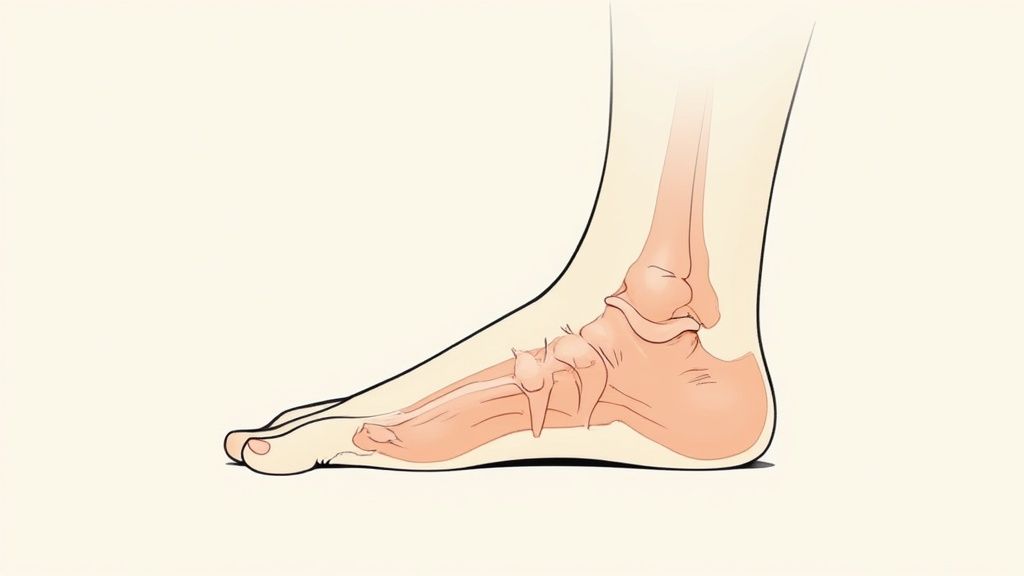
At its core, the problem is constant, repetitive strain on your plantar fascia ligament. Think of this ligament as a bowstring that supports the arch of your foot. When it's repeatedly overstretched and overloaded, it gets inflamed, irritated, and incredibly painful.
This is where specialized inserts come in. They are designed to fix the problem from the ground up by delivering two critical things:
- Arch Support: An insert props up your foot’s arch, preventing it from collapsing with each step. This simple action dramatically reduces the pulling and stretching forces on the plantar fascia, giving it a much-needed break to heal.
- Heel Cushioning: A deep, cushioned heel cup is a game-changer. It absorbs the jarring shock of every foot strike, protecting the most tender spot on your foot. This is particularly important for easing the pain from heel spurs, which often go hand-in-hand with plantar fasciitis.
It's this two-pronged approach that makes these simple devices so powerful. They can completely change your ability to walk, stand, and exercise without constantly wincing. Inserts offer a clear path back to the things you love, whether that's a morning walk, getting through a long workday, or just playing with your kids.
The Growing Need for Effective Solutions
If you're dealing with this, know that you are far from alone. Heel pain is one of the most common foot problems people face, and the search for reliable treatments has created a huge market for solutions.
The global plantar fasciitis treatment market was valued at around USD 1.53 billion and is projected to climb to about USD 2.49 billion by 2032. This surge shows just how many people are struggling with heel pain and related foot issues.
This isn't just a random statistic; it highlights a real, widespread need for relief. It’s no surprise that orthotics and inserts are often recommended as the first line of defense. They work, they're affordable, and they don't require surgery or injections. You can dig deeper into these trends in this detailed report on plantar fasciitis treatments.
To put it simply, inserts work by correcting the underlying biomechanical issues causing the strain. The table below breaks down exactly how they provide relief.
How Inserts Provide Plantar Fasciitis Relief
| Benefit | How It Helps Your Foot | What It Means For You |
|---|---|---|
| Arch Support | Prevents the arch from collapsing and overstretching the plantar fascia. | Less pulling and tearing on the ligament, allowing it to heal. |
| Heel Cushioning | Absorbs the shock and impact from walking and standing. | Immediate relief from that sharp, localized heel pain. |
| Improved Alignment | Corrects foot posture and distributes weight more evenly. | Better stability and less strain on your entire foot, ankle, and leg. |
| Pressure Redistribution | Shifts pressure away from the inflamed area of the heel. | Reduced pain with every step, making it easier to stay active. |
By addressing these key areas, a good insert doesn't just mask the pain—it creates an environment where your foot can actually begin to recover. This guide will walk you through how to choose the right one to join the millions who have found lasting relief.
Why Your Feet Hurt: A Simple Explanation
To really get a handle on fixing foot pain, you first have to understand what’s going on in there. It helps to think of your foot like a classic bow and arrow set. The arch of your foot is the sturdy, curved bow, and the long ligament on the bottom—the plantar fascia—is the bowstring that holds that supportive curve.
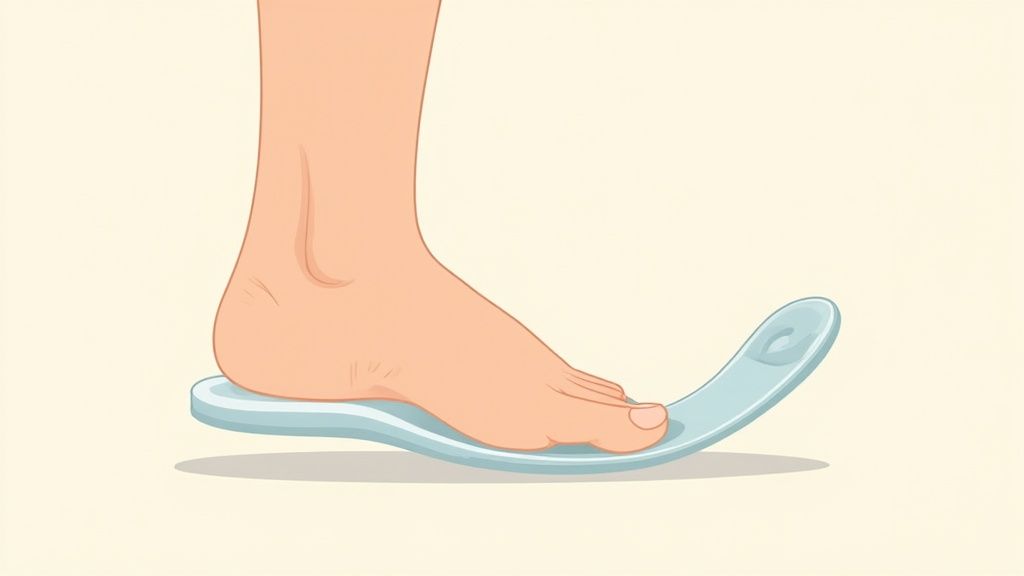
Every single time you take a step, that bowstring tenses and releases to absorb the shock of your entire body weight hitting the ground. It’s an incredibly tough piece of tissue, designed for resilience, but even the strongest structures have a breaking point.
When that ligament gets stressed out day after day, it starts to get irritated and inflamed. Tiny micro-tears begin to form, and that’s when you feel that sharp, stabbing pain we call plantar fasciitis. The pain is your body’s alarm bell, signaling that the "bowstring" has been pulled too tight for too long.
What Stresses the Plantar Fascia?
So, what pushes this vital ligament over the edge? Usually, it's a combination of a few common culprits. Pinpointing these triggers is key because it shows you exactly what mechanical issues need to be addressed.
-
Prolonged Standing: If your job keeps you on your feet all day, you're putting constant, low-grade stress on your plantar fascia. That strain builds up over time, especially without proper support.
-
Sudden Increases in Activity: Ever jump into a new workout routine with a little too much enthusiasm? A sudden spike in activity, like starting a new running program, can easily overload the ligament before it can adapt.
-
Foot Structure: The very shape of your foot is a massive factor. Both high arches and flat feet can create mechanical problems that pave the way for plantar fasciitis.
Another huge contributor is simply wearing the wrong shoes. Footwear that’s too tight, narrow, or flimsy forces your foot into an unnatural position, adding a ton of extra strain. A very common reason for ongoing pain is simply a bad shoe fit. For a deeper dive, check out the ultimate guide to wide width shoes.
High Arches vs. Flat Feet
It might sound strange, but having arches that are too high or too low can lead to the exact same painful condition, just for opposite reasons.
High Arches (Pes Cavus)
A foot with a high arch tends to be quite rigid. It doesn't do a great job of absorbing shock. Instead of distributing impact evenly, the force from walking or running gets slammed directly into the ball of the foot and the heel.
A rigid, high arch acts like a tripod, focusing immense pressure on the two points where the plantar fascia attaches—the heel and the forefoot. This keeps the “bowstring” pulled tight almost all the time, making it incredibly vulnerable to injury from normal daily life.
Flat Feet (Pes Planus)
At the other end of the spectrum are flat feet, sometimes called "fallen arches." Here, the problem is too much flexibility. The arch collapses downward with every step, causing the foot and ankle to roll inward. This motion is called overpronation.
This constant inward roll yanks on the plantar fascia, stretching it out like a rubber band being pulled too far, over and over again. This repetitive stretching is a direct line to the micro-tears and inflammation at the heart of plantar fasciitis.
Whether your foot is too rigid or too flexible, the result is an overworked, strained, and painful plantar fascia. This is exactly where inserts for plantar fascia come in. They work by correcting these underlying mechanical flaws, giving your foot the specific support it needs to move without pain. They help build a better foundation, right from the ground up.
How the Right Inserts Get Your Feet Working Properly Again
It might seem strange that a simple piece of material slipped into your shoe can make such a huge difference, but it's not magic. It's all about biomechanics. A good insert for plantar fasciitis is designed to do three key jobs that work together to fight the forces causing your pain.
Think of it as giving your foot the support system it's been missing.
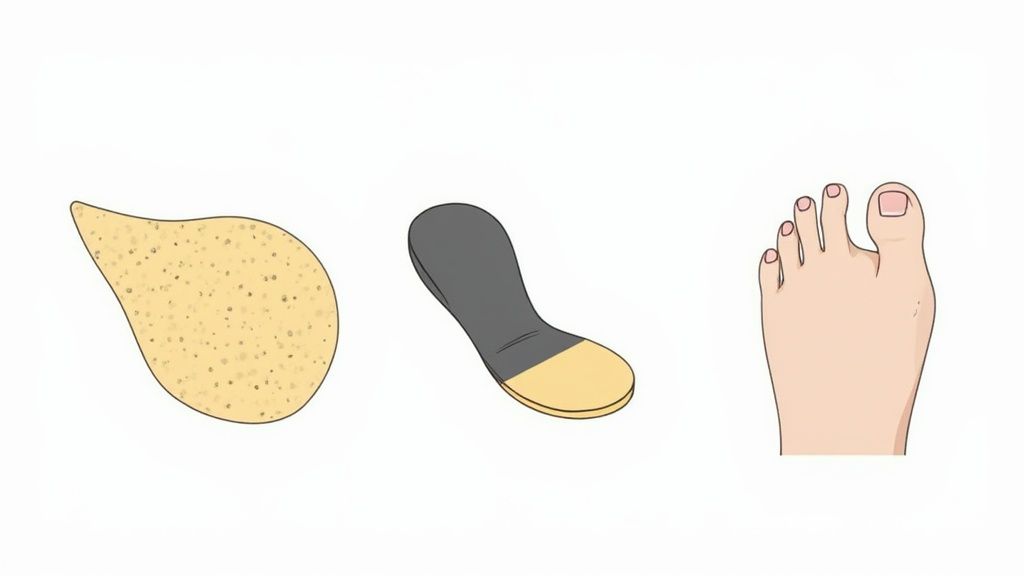
First and foremost, a proper insert provides arch support. Your arch is like a bridge, and the plantar fascia is the main cable holding it up. If that bridge sags (like with flat feet) or is stretched too tightly (high arches), the cable gets yanked and strained. An insert slides in underneath, acting like a support pier to hold the bridge in its proper shape.
This is the most critical function. By keeping your arch from collapsing with every step, the insert takes the constant, painful pulling pressure off the plantar fascia. This finally gives that inflamed tissue a chance to rest and heal instead of being re-injured all day long.
Cushioning the Impact and Guiding Your Step
Next up is heel cushioning. That spot where the plantar fascia attaches to your heel bone? That's ground zero for the stabbing pain. An insert with a deep heel cup and shock-absorbing padding acts like a personal bodyguard for this tender area, softening the blow every time your foot hits the ground.
Finally, a quality insert provides motion control. Many of us with plantar fasciitis have feet that roll too far inward when we walk, a motion called overpronation. This creates a nasty twisting force on the plantar fascia. A well-designed insert with a solid structure helps guide your foot into a more natural, neutral alignment, putting a stop to that damaging roll.
By correcting your foot's alignment, inserts do more than just stop foot pain. They build a stable foundation for your entire body. This can ease stress on your ankles, knees, and even your lower back, fixing the chain reaction of pain that started at your feet.
These three functions—support, cushioning, and control—all work in sync. They offload the stressed ligament, correct bad walking habits, and absorb painful impact. This three-pronged attack is exactly why inserts are a cornerstone of treating plantar fasciitis effectively.
The Proof Is in the Numbers (and the Relief)
The success of this biomechanical approach has made orthotics a go-to solution for millions. In fact, the market for foot orthotic insoles, which includes inserts for plantar fascia, was recently valued at around USD 2.5 billion and is still growing. That growth is fueled by people just like you looking for reliable, non-surgical ways to get relief.
This huge market proves a simple point: using the right support to correct how your foot functions really works. But what does that support actually do for different foot types?
- For Flat Feet: The insert props up the collapsing arch, which stops the inward ankle roll (overpronation) that constantly yanks on the plantar fascia.
- For High Arches: The insert fills the gap under the arch, helping to spread your body weight more evenly instead of concentrating it all on the heel and ball of the foot.
No matter your foot shape, the goal is the same: reduce the unnatural strain on the plantar fascia. To dig deeper into how different designs accomplish this, check out our comprehensive guide to arch support orthotic insoles. Once you understand how these devices restore proper function, you can see why they deliver such genuine, lasting relief.
So Many Inserts, So Little Time: A Guide to Choosing the Right One
Walking into a pharmacy or searching online for plantar fasciitis inserts can feel like a fool's errand. The options seem endless—gel pads, foam cushions, hard plastic devices. It’s enough to make your head spin. But here’s the thing: understanding the fundamental differences between them is the key to finding real relief.
Picking the right insert isn’t just about comfort; it’s about fixing the problem. The wrong choice could leave you right where you started, frustrated and still in pain.
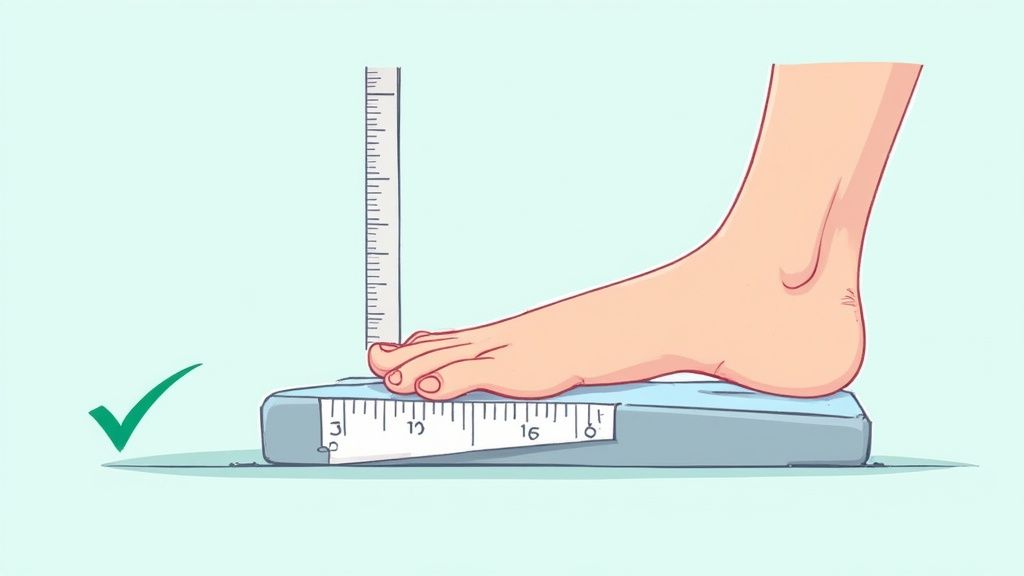
The market for foot relief products is absolutely booming, which tells you just how many people are desperate for a solution. In fact, the global orthopedic insole market is on track to more than double, from $3.2 billion to $6.7 billion by 2035. That’s a whole lot of inserts! You can read a full market analysis from Future Market Insights if you're curious about the numbers.
Let’s cut through the noise and break down the main types of inserts you’ll find. This will make your decision a whole lot easier.
Soft Cushioned Insoles
These are the inserts you’ll see lining the shelves at any drug store. They’re usually made of gel, memory foam, or a very soft foam called EVA.
Their job is simple: to provide a soft, pillowy layer inside your shoe. Think of them as tiny mattresses for your feet. They cushion, but they don't support.
These are best for someone with general foot fatigue or who just wants a bit more shock absorption. While they might feel nice on a sore heel for a little while, they don’t actually do anything to stop the plantar fascia from overstretching, which is the root of the problem.
Soft insoles feel great at first, but they lack the backbone to stop your arch from collapsing. For real plantar fasciitis relief, you need an insert that actually supports your arch and reduces the strain on that ligament.
Semi-Rigid Orthotic Inserts
For most people struggling with plantar fasciitis, this category is the gold standard. You'll often hear them called "off-the-shelf" or "prefabricated" orthotics, and they're specifically engineered to give you both support and cushioning.
They’re built with a combination of materials. A firm, supportive shell (usually a dense composite or plastic) props up your arch, while foam layers provide comfort and absorb impact.
The main goal of a semi-rigid insert is to support the arch and stop your foot from rolling inward too much (a motion called overpronation). This is what directly takes the tension off the plantar fascia. This is the category where products like Samurai Insoles shine, as they're built to deliver targeted, effective support right out of the box.
Custom-Molded Orthotics
This is the top-tier, most personalized—and most expensive—option. To get these, you’ll need to see a podiatrist or an orthotist who will take a mold or a 3D scan of your feet.
These are crafted just for you, using materials like rigid plastics, carbon fiber, or flexible composites, all based on your doctor's prescription. Their purpose is to correct serious or complicated biomechanical problems that are unique to your feet and the way you walk.
Custom orthotics are typically for people with unusual foot shapes, severe pronation issues, or for those who’ve tried everything else without success. They can be incredibly effective, but because of the high cost and the time it takes to get them made, they’re usually the last resort in a treatment plan.
Comparison of Plantar Fascia Insert Types
To help you see the differences at a glance, we've put together a simple comparison table. This breaks down the three main categories so you can quickly see which one might be the best fit for you.
| Insert Type | Key Feature | Best For | Average Cost | Pros | Cons |
|---|---|---|---|---|---|
| Soft Cushioned | Pure cushioning, no support | Mild foot fatigue, extra comfort | $10 - $30 | Inexpensive, widely available | Lacks support, doesn't address the root cause of pain |
| Semi-Rigid | Balanced support and cushioning | Most plantar fasciitis cases | $40 - $80 | Effective support, affordable, readily available | Not custom-fit for unique foot shapes |
| Custom-Molded | Medically prescribed, exact fit | Severe or complex foot issues | $300 - $800+ | Perfectly tailored to your foot | Very expensive, requires a doctor visit, time-consuming |
When you boil it all down, starting with a well-designed, semi-rigid orthotic is the most practical and effective path to relief for most people. It gives you the critical arch support needed to tackle the cause of plantar fasciitis, all while being affordable and easy to get.
How to Choose the Perfect Inserts for You
With so many options out there, trying to pick the right insert can feel a bit overwhelming. But it doesn't have to be a guessing game. By thinking through a few simple things—your feet, your daily life, and your shoes—you can narrow down the choices and find a pair that actually works.
Think of it like being a detective for your own two feet. To solve the mystery of your foot pain, you need to gather three key clues: your arch type, how active you are, and the shoes you live in. Get these three right, and you're well on your way to relief.
Step 1: Figure Out Your Arch Type
Before you can properly support your arch, you have to know what kind you’re working with. Do you have flat feet? High arches? Or are you somewhere in the middle? A quick "wet test" at home can give you a surprisingly accurate answer.
Here’s all you have to do:
- Pour a little water into a shallow pan.
- Get the bottom of one foot completely wet.
- Carefully step onto a piece of cardboard or a dark towel—anything that will show a clear footprint.
- Step off and take a look at the imprint you left behind.
The shape of that wet footprint tells the whole story. A full, solid shape means you likely have flat feet. If you only see your heel and the ball of your foot with a thin line connecting them (or no line at all), you've got high arches. A print with a nice, visible curve along the inside is the classic sign of a neutral arch.
This simple test immediately tells you what kind of support to look for. Flat feet need inserts that stop the arch from collapsing, while high arches need help distributing pressure and adding a bit of cushion.
Step 2: Think About Your Daily Grind
Next, what does your average day look like? The kind of stress you put on your feet will determine the type of insert you need. An insole built for a marathon runner is probably not the right fit for an office worker.
- High-Impact Activities: If you’re a runner, a tennis player, or work on concrete all day, you need superior shock absorption. Your feet are taking a constant pounding, and the right insert can soften the blow.
- Lots of Standing: For people who are on their feet for hours—think teachers, nurses, or retail staff—a firm, supportive arch is the top priority. The goal here is to prevent your arch from slowly giving in to gravity over a long day.
- General Daily Wear: Just looking for better comfort while running errands or walking the dog? A balanced, semi-rigid insert that offers a good mix of support and flexibility is often the perfect solution.
Step 3: Make Sure the Insert Fits Your Shoes
This last step is crucial. An insert can’t help you if it doesn’t fit inside your shoes. You can't stuff a thick, heavy-duty insole into a pair of slim dress shoes and expect it to work.
Take a look at your shoe rack. What do you wear the most? Work boots? Sneakers? Casual loafers? Inserts are made in different thicknesses and volumes. A high-volume insert made for a roomy hiking boot simply won't fit into a low-profile flat.
Always choose an insert that’s compatible with the shoes you spend the most time in. In some cases, you might even need a couple of different pairs for different shoes to get consistent support. For more tips on this, check out our guide on how to choose the right insoles.
By taking a moment to consider these three things, you can cut through the confusion and find inserts that are truly made for you—and get back to walking without pain.
Getting the Most From Your New Inserts
Finding the right inserts is a fantastic first step toward getting back on your feet, pain-free. But like any good tool, knowing how to use them correctly is what really makes the difference. Think of it less like a magic pill and more like a new piece of high-performance gear—it takes a little setup to get it dialed in.
First things first, let's get the fit right. Most quality inserts are made to be trimmed for a perfect, custom-like fit inside your shoe. Just take the flimsy factory insole that came with your shoe, lay it over your new insert, and trace around the toe. A careful snip along that line will ensure it sits perfectly flat without any annoying bunching.
And this is a big one: always remove the shoe's original insole before adding your new one. Stacking inserts creates a cramped, unstable mess inside your shoe. It completely negates the support your new insert is designed to provide and can actually make your foot pain worse.
The Break-In Period
Just like a good pair of leather boots, your new inserts need a break-in period. Don't be alarmed if they feel a bit odd—maybe even a little uncomfortable—at first. That's totally normal. Your foot has likely been working in a stressed, misaligned way for a while, and the insert is gently guiding it back to where it should be.
The trick is to introduce them to your feet gradually.
- Day 1-2: Start by wearing them for just 1-2 hours.
- Day 3-5: Bump that up to 3-4 hours a day.
- Day 6 and beyond: Keep adding an hour each day until you can wear them all day long without a second thought.
This slow-and-steady approach gives the muscles and ligaments in your feet time to adapt to their new, healthier alignment without getting overwhelmed. If you feel any real pain, just take them out and try again tomorrow for a shorter duration.
Creating a Complete Recovery Plan
Inserts are powerful, but they work best as part of a team effort. When you pair them with other simple, proven habits, you can speed up your recovery and help prevent that nagging pain from ever coming back.
- Targeted Stretching: Gently stretching your calf and the bottom of your foot (the plantar fascia itself) is a game-changer, especially first thing in the morning. It helps release that overnight tightness.
- Supportive Footwear: Your inserts can't do all the heavy lifting on their own. The shoes you put them in matter. Pairing them with footwear designed for all-day comfort, like breathable and cozy work shoes, will only amplify the benefits.
- Regular Maintenance: A quick wipe-down with a damp cloth will keep your inserts fresh. But remember, even the best inserts have a lifespan. With daily wear, expect to replace them every 6-12 months to ensure you're still getting the full support you need.
For a deeper dive into building a comprehensive plan, our article on support insoles for plantar fasciitis is an excellent resource.
Common Questions About Plantar Fascia Inserts
Even after reading through a guide, it's natural to have a few more questions pop up about using inserts for plantar fasciitis. That's a good thing! It means you're really thinking about how to make this work for you. Let's clear up some of the most common questions so you can move forward with confidence.
People often ask, "How quickly will these actually work?" While you might feel a bit of nice cushioning right away, the real healing doesn't happen overnight. Most people start to feel a real, noticeable difference in their plantar fasciitis pain within the first one to two weeks of wearing them consistently. This is the time it takes for your foot to get used to the new support and for the strain on that overworked ligament to finally ease up.
Another frequent question is about shoes. "Do I really need inserts in all of them?" In an ideal world, yes. The whole point is to give your plantar fascia constant, reliable support to prevent it from getting strained again. You can certainly move a single pair of inserts between your most-used shoes, like from your work boots to your running shoes. But having dedicated pairs for the shoes you live in is the best way to make sure you never miss out on that crucial support.
Do I Need Custom Orthotics?
This is a big one. It's easy to think that the only "real" solution is a super expensive, custom-molded orthotic from a specialist. But here’s the truth: for the vast majority of people with plantar fasciitis, a well-made, semi-rigid insert gives you all the support you need to fix the problem, without the hefty price tag and multiple appointments.
Think of it like this: custom orthotics are the heavy-duty prescription medication, best saved for very complex or severe foot problems. A high-quality, over-the-counter orthotic is like a powerful, effective medicine you can get without a prescription—it works wonderfully for most situations and is much easier to get.
Unless a podiatrist has specifically told you that you need custom orthotics after trying everything else, or if you have a significant foot deformity, starting with a top-notch prefabricated insert is the smartest and most effective first step.
Can Inserts Make My Feet Weaker?
That's a fair question. It makes sense to wonder if propping up your feet will make your muscles lazy. The answer is a clear no—as long as you use the right kind of insert.
A flimsy, squishy gel insole won't do much for your foot mechanics. But a truly supportive orthotic insert does more than just cushion; it actively guides your foot into its proper, natural alignment. This actually helps your muscles work better by stopping harmful patterns like overpronation. By correcting your foot's posture, it allows your muscles to function efficiently, just as they were meant to.
To get the best results, pair your inserts with simple foot-strengthening exercises like towel scrunches or calf raises. This creates a complete system for recovery. The inserts aren't a crutch that causes weakness; they are a tool that enables proper function and a vital part of your healing journey.
Ready to give your feet the support they need to finally heal? Samurai Insoles are biomechanically engineered to fight plantar fasciitis pain by providing the perfect balance of arch support and cushioning, right out of the box.
Find Your Perfect Pair of Samurai Insoles and Start Walking Pain-Free
